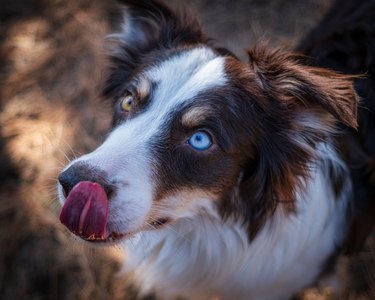Like humans, a dog's eyes produce tears as a protective measure. When their eyes don't generate enough lubricating film, they develop keratoconjunctivitis sicca (KCS), or dry eye, resulting in inflamed, irritated, and painful eyes. Any dog showing eye problems such as red painful eyes or ocular discharge should be seen by a veterinarian to receive a diagnosis and treatment plan.

Video of the Day
What is dry eye in dogs?
Dry eye occurs in dogs when there is a deficiency in the water portion of the dog's tear film. When there is a water deficiency, a dog's tears may only consist of oil and mucus. At this point, the dog will likely display the gooey yellow eye discharge that is a defining characteristic of dry eye.
Video of the Day
What do tears do for a dog’s eyes?
A dog's tears provide lubrication for their cornea and flush away irritants that get into their eyes. Tears are made of water as well as some oil and mucus. They also contain anti-bacterial proteins and salts to remove infectious agents that could cause a bacterial infection.

Causes of dry eye in dogs
There is a variety of common causes for a dog's lack of adequate tear film, including:
- Diseases, such as distemper
- Head or eye trauma
- Thyroid conditions
- Neurogenic conditions
- Allergies
- Autoimmune disease
- Infections and reactions to medication
- Inflammatory reactions to tear gland tissue in certain dog breeds, such as American cocker spaniels, English bulldogs, Lhasa apsos, and West Highland white terriers
- Flat-faced breeds such as Shih tzus or pugs are more likely to develop dry eye
Symptoms of dry eye in dogs
Cloudy eyes from discharge that turns to thick, sticky, and colored discharge is a common symptom of dry eye in dogs. The discharge often becomes crusty and adheres to a dog's eyelids and eyelashes. Dogs with dry eye may also blink excessively, squint, develop light sensitivity, and start pawing at the eye out of discomfort. Other signs include a prominent third eyelid and swelling in the tissue that surrounds the eye. Additionally, eye conditions such as corneal ulcers may occur as a result of dry eye.
Can you use human eye drops for dry eyes in dogs?
No, human eye drops should not be used to treat dry eye in dogs. A veterinarian will suggest or prescribe eye drops that are appropriate for use in dogs. Human products should never be used unless they have been specifically recommended by a veterinarian.

Treatment of dry eyes in dogs
Treatment of dry eye in dogs begins with addressing the underlying causes of the condition. Veterinarians will likely prescribe prescription medications, such as cyclosporine, pilocarpine, and tacrolimus, which stimulate tear production and protect the cornea. Depending on the condition, antibiotics and steroids may also be prescribed.
If a dog doesn't respond to medical management, they may need to have surgery to relocate the parotid duct to the eye. This allows saliva from the parotid gland to lubricate the eye.
Most dogs with dry eyes require lifelong medication, but they may require less medication as time goes on. Because dry eye not only causes severe pain to the dog but can also permanently damage the cornea, it's important that dogs with dry eye receive treatment and regular monitoring from a veterinarian.
Are there any home remedies for a dog’s dry eyes?
No, there aren't any home remedies that will completely treat a dog's dry eyes. It's important to clean the eyelids and area around the eyes regularly with a damp washcloth to prevent irritation and secondary skin infections. However, a veterinarian is still needed to diagnose the underlying condition and prescribe an appropriate treatment plan even if over-the-counter supplements or medications are to be used.
If an owner wants to pursue herbal or natural remedies, they should work with a naturopathic veterinarian to come up with a treatment plan for their pet's eyes.
The bottom line
Tears are vital for a dog's eye health and overall wellness. Without an adequate amount of water in a dog's tears, dry eye can occur. To properly treat dry eye in dogs, your DVM will need to examine the dog and determine the underlying cause of dry eye. Once a cause has been determined, a treatment and management plan can be implemented to make the dog feel more comfortable and to prevent further issues.